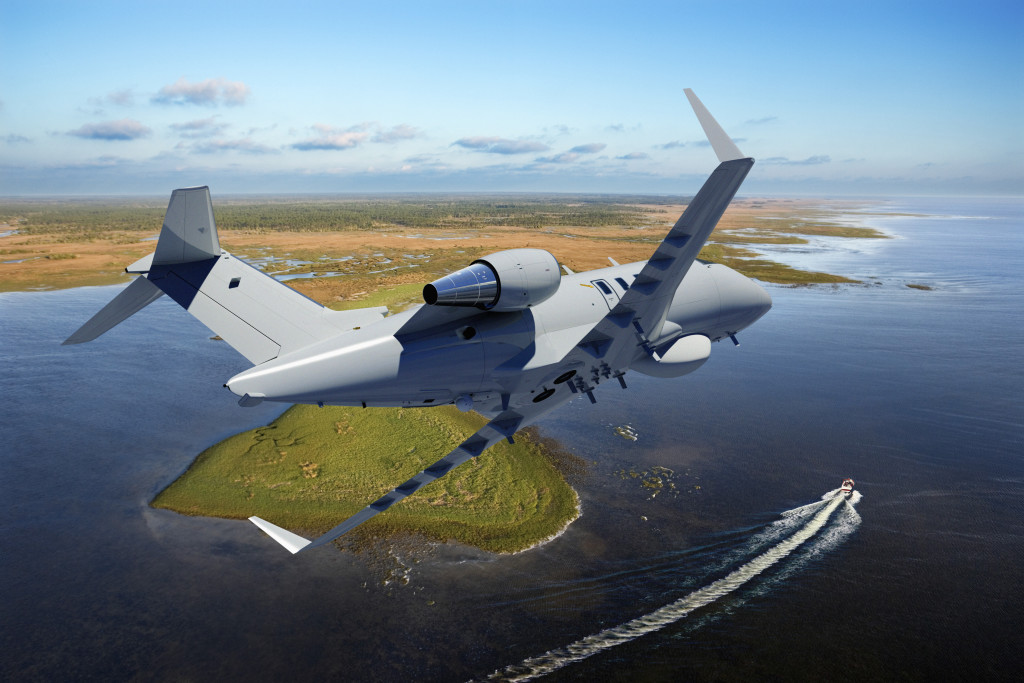
OTTAWA – At this year CANSEC, Boeing exhibited a full range of products from SDB to Blackjack unmanned aerial system to satellites without forgetting the F/A-18 Super Hornet, a potential contendor for the replacement of the aging Canadian Forces McDonnell Douglas CF-18 procured in the beginnings of the 1980’s.
But Boeing only press conference held on May, the 27th, was aimed at the Maritime Surveillance Aircraft program or MSA designed for search and rescue, anti-piracy, coastal and border security missions. Matt Carreon, MSA Business Development at Boeing Military Aircraft and Brian Love, Chief Commercial Officer at Field Aviation gave a 25 minutes update on the program as they did in 2014.
Boeing decided to put the emphasis on this program not only because Canada could be a potentiel customer but because it is using a Canadian-built airframe, a Challenger Serie 600, modified by a Canadian Compay, Field Aviation.
The people at Boeing Defense, Space & Security (BDS) whose close to a third of sales are now international identified a need for maritime patrol from international customers. Having developped from the Boeing 737 jetliner frame, a replacement for ubitiquous P-3 Orion/Aurora, the P-8A Poseidon in service in the US and Indian Navies, Boeing thought of a smaller plane. As said by Mr. Carreon, Boeing built on its experience on the P-8I and 737 AEW&C Wedgetail delivered to the Royal Australian Air Force.
Having detected a market for countries which do not need the anti-submarine and anti-surface warfare weapons, Boeing launched the MSA program in July 2012 at Farnborough International.
After a full-fledge selection, in November 2013, Boeing picked the Bombardier Challenger 605 because of its internal space, payload and cooling capacities, quick dash speed to get to the patrol zones and long endurance while patrolling as well as room for growth as recalled Matt Carreon. On top of it, with a fleet of more 900 Challenger worldwide, the parts and the support are easily available. ‘It’s a low cost, low risk solution’ underlined Matt Carreon.
In order to promote the MSA, Boeing decided to launch a demonstrator. Built on a Challenger 604, the demonstrator was modified by Toronto-based Field Aviation. Having already modified 50 aircraft including five Bombardier Challenger in the past for special missions, Field Aviation undertake the airframe and interior modification work. A ventral radome for a multimode search radar and a pressurized box to provide for a retractable electro-optic/infared sensor. Antennas were installed to serve other surveillance systems, such as communications intelligence. It is equipped with a Selex ES Seaspray maritime surveillance radar, a FLIR Systems Star Safire 380-HD EO/IR turret, SigInt systems and three up to five operators stations. In spite of having facilities in Calgary and Oklahoma City, Field Aviation will modified production aircraft at Toronto said Brian Love.
It can be easily converted in a very few hours in a medivac or VIP configuration. Any mission system upgrade could be easily made thanks its open architecture and wiring and cooling systems recalled Matt Carreon.
Boeing foressees over the next ten years a market of ten billion dollars or 165 aircraft.
The MSA demonstrator, a Boeing owned Challenger 604 that is very similar to the current production Challenger 650 according to Mr. Carreon, took the sky for the first time at Field at Pearson International Airport in Toronto on February, the 28th 2014 for a four hours flight. It was then flown to Yuma, Arizona for certification flight trials before joining Seattle for installation of the mission equipment.
Any Challenger 604, 605 or 650, brand new or used could be converted into a MSA according to Brian Love. Boeing is planning for a 1000 hours utilization rate a year which is very typical for that kind of missions.
Matt Carreon recalled that the Direct operations costs of a Canadian Forces CP-140 Aurora is $19000 and the one of the MSA will be approximatively one third. For him, the MSA for Canada could complement the CP-140 whose retirement is expected in 2030 or even replace it that could translate in both cases in large savings. $250 millions over the next ten years could be saved by used the CP-140 and the MSA alongside.
As summarized Mr. Carreon, ‘the MSA is Canadian aircraft modified by a Canadian company…A Canadian solution for Canada’
Shown at Farnborough International last year and at LIMA last March, the MSA demonstrator is expected to be at the Royal Air Tatoo this year besides demonstrations to various air forces around the world.
Diplômé universitaire en histoire, journalisme et relations publiques, en 1993, Philippe Cauchi amorce une carrière de journalisme, analyste et consultant en aérospatiale. En 2013, il fonde avec Daniel Bordeleau, le site d’information aérospatial Info Aéro Québec.
Commentaires